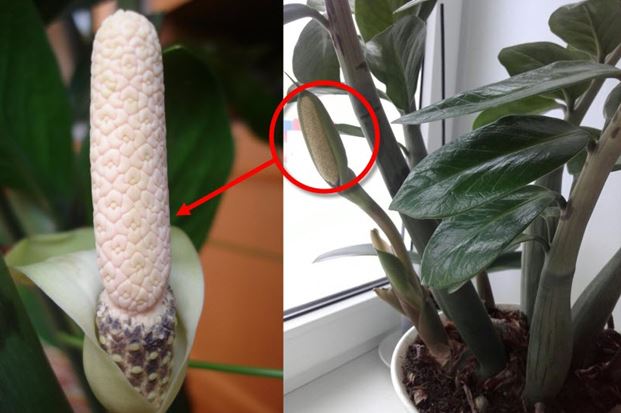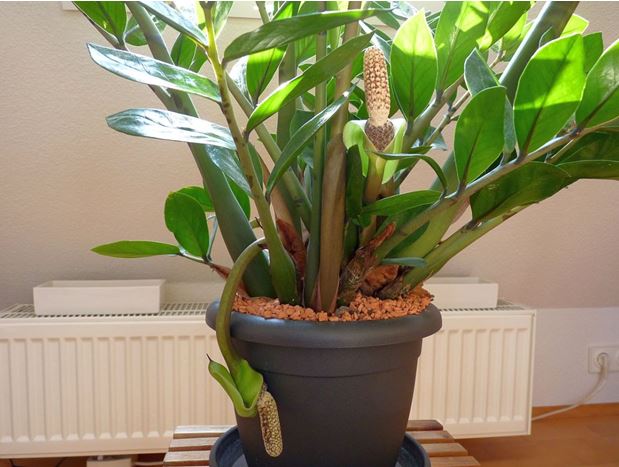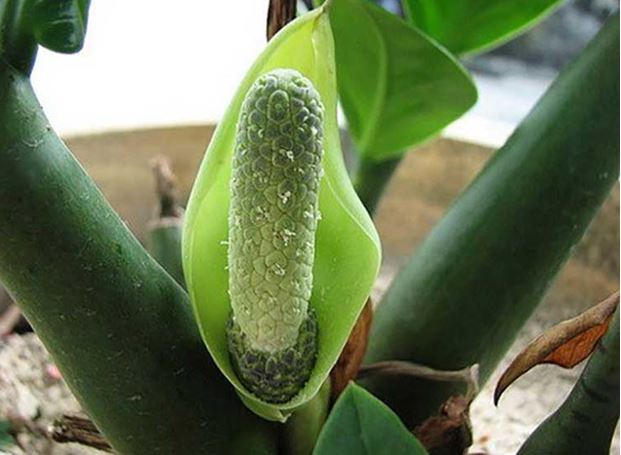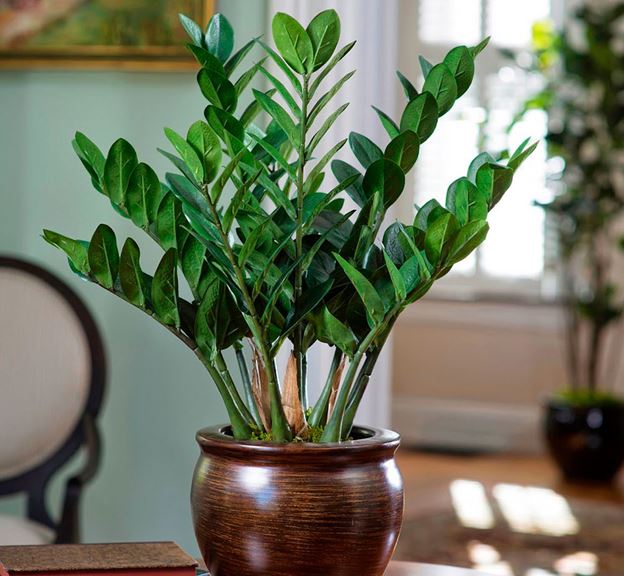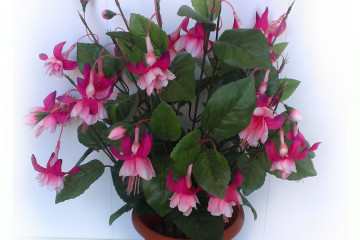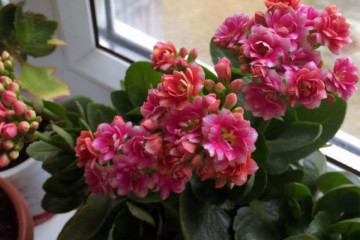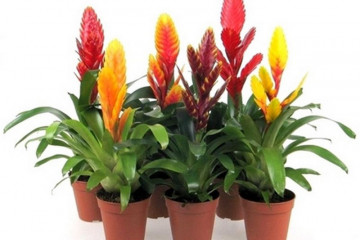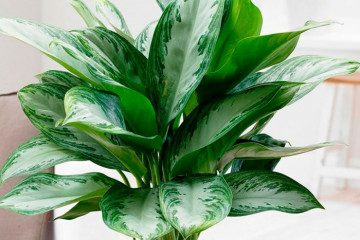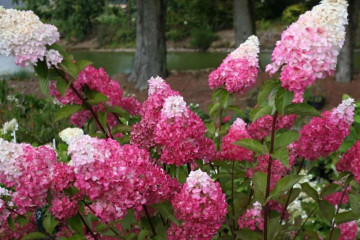How zamioculcas blooms at home
Content:
Many growers prefer unpretentious specimens of the Aroid family and, with proper care, observe how the zamioculcas (dollar tree) blooms. An exotic plant native to the tropical latitudes of Africa, unites 4 varieties of the variety (zamielistny, variegated, lanceolate, black), has odd-pinnate glossy leaves that form a regular rosette. The height of a houseplant reaches one meter. Life expectancy is 5-10 years. The cut juice is toxic. The inflorescences have no aesthetic value, look faded, often merge with the foliage. The smell is unpleasant.
Zamiokulkas blooms or not
In nature, zamioculcas allows flowering to be observed from mid-summer to early autumn, in indoor conditions the plant is valued for the decorative properties of the leaves, it is quite difficult to achieve a blooming effect. The peduncle develops vertically upward. When ripe, the shoot bends towards the ground, taking a horizontal position. The flowering period reaches several weeks.
Under natural conditions, the flowering of the succulent zamioculcas is accompanied by the formation of ovaries and the maturation of single-seeded brown berries. The fruits do not ripen in greenhouse conditions, the growing season of the variety is carried out by cuttings of leaves, stems and stratification of tubers.
What does a zamioculcas flower look like?
Many tuberous plants are characterized by the division of the cob into 2 parts: the female zamioculcas flower places the female flowering at the bottom of the process, the male at the top, separated from the opposite sex by a sterility zone (a light strip devoid of sexual characteristics). Small inflorescences of zamiokulkas have a creamy shade, collected in an ear 5-8 cm long. The interval from the top of the peduncle to the root system of the culture is 20 cm. Scientists explain the factor by the peculiarity of pollination performed by crawling insects. Self-pollination is not possible.
Are flowers poisonous? Representatives of the Aronnikov family of plants contain toxic substances in the juice. Zamioculcas is no exception. The toxicity of monocotyledonous domestic plants is attributed to a weak or medium level, requiring maximum caution when manipulating the southern handsome. Contact with the culture without gloves, contact of the juice on the skin cause an allergic reaction.
How often does zamioculcas bloom?
The culture is considered shade-tolerant, takes root well on the northern windows, forming inflorescences in adulthood (after 5-6 years). Placing it on the east or south window, growers every 1-2 years manage to observe the zamioculcas how often it blooms at home. The flowering period lasts about one to two weeks, then the shoot darkens and falls off. Withering of an unripe peduncle or young foliage indicates excessive watering, too low a temperature in the apartment, or a plant disease.
How to make bloom
Top dressing
Domestic succulents tend to accumulate liquid inside the leaves and stems, they consume water as needed. The deficiency of nutrients is reflected in the appearance of the plant, making it possible to determine why the foliage turned yellow, the shoots stretched out, and dark spots appeared.
The first time fertilization is applied to the soil before the start of the phase of active development of the "dollar tree". Usually the period falls in the first month of spring. In winter, the amount of fertilizer is reduced to a minimum or completely abandoned. In the spring, in the summer, the culture is fed at the root and the leaves are sprayed twice a month.
Recharge is required for zamiokulkas during the growing season, fertilizers are applied every 14 days. For feeding zamiokulkas, mineral or organic fertilizers for cacti and succulents are suitable. The most popular are Agricola, Agricola Aqua, Pocon, Uniflor-growth, Uniflor-bud, Master Color. Universal formulations diluted in the required concentration are suitable. Step-by-step instructions for feeding zamiokulkas provide for the introduction of nutrients exclusively into moist soil.
Foliar dressing is recommended once / month. The ideal proportions of the composition are 1 gram or 1 ml of the nutritional complex per liter of water. Dissolved compounds are used to treat dry and healthy leaves.
Moisture regime of the soil in the pot
The culture loves moderate watering, once every one or two weeks - the optimal regime for the spring-summer period. Before moistening the tree, you should check whether the earthen lump is dry. In winter, indoor water evaporates slowly. Zamioculcas are watered with small portions of warm water. Stagnation of moisture provokes yellowing of the leaves, rotting of the roots.
If the flowers of the zamiokulkas have bloomed, the watering regime, temperature, lighting should not be changed, avoiding stressful situations. A good solution would be a combination of two watering methods: fill the tray with liquid and water from above. In a pan filled with water, it is enough for the pot to brew for 15 minutes, the tuber will absorb the required level of moisture, the rest of the liquid is drained from the pan. When the soil is moistened from above, the water will be evenly distributed, overflowing the culture is not threatened. The water drained into the pan is drained.
Pot size
Zamiokulkas flowers do not bloom both in volumetric tanks and in tight containers. In the first case, there is an excessive growth of roots instead of a peduncle, in the second, a rapid depletion of the soil. Lack of nutrients in the soil weakens the plant. Zamioculcas attack pathogens and pests that prevent flowering.
Transplanting zamiokulkas into pots of appropriate sizes.
What to do with a flower after flowering
The "sleep mode" of the money tree lasts from October to April. During the rest period, you should reduce hydration to one to two times / month. There is no need to feed the plant in winter. Zamioculcas is placed in a well-lit place, maintaining an air temperature of 16-20 ° C. "Women's happiness" prefers diffused sunlight all year round.
Immediately after flowering, it is not recommended to transplant or reproduce a flower. Typical instructions on what to do with the flowers of zamiokulkas after the active phase of flowering, suggest limiting yourself to minimal watering and top dressing, to restore strength, the plant is placed in a cool room, avoiding drafts and sudden temperature fluctuations.
Florist errors
Excessive custody becomes a common mistake in caring for zamiokulkas. Overfilling and overfeeding plants harm the succulent more than insufficient care. Owners of a green miracle should not interfere with the measured life of an East African plant unnecessarily.
Tropical plant after flowering at rest.
Signs and superstitions
The name "dollar tree" refers to the plant's ability to attract material wealth. Blooming of the southern succulent is a sign of a positive atmosphere for attracting success, happiness, wealth. This statement is especially common in offices. And, conversely, yellowing of foliage, flower diseases promise financial problems.
Less well known is the name "flower of celibacy", flowering for the holders of the culture is a bad sign, obtained due to the similarity with spathiphyllum. A copy received as a gift allows you to buy off negative energy with several coins.
